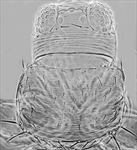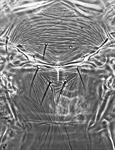
Antenna

Head & pronotum

Mesonotum & metanotum

Abdominal pleurotergites II–III

Tergites VII–VIII

Male sternites

Fore wing
Both sexes fully winged. [Nakahara (1994) indicates that the body of this species is variable in color, from yellow to yellowish brown to brown; the notes below are based on yellow specimens identified by W. Ewart.] Body and legs yellow, major setae pale; antennal segments V–VI with apex brown, VII brown; fore wings pale. Antennae 7-segmented; segments III & IV each with short forked sense cone. Head wider than long; two pairs of ocellar setae; pair III small, arising outside ocellar triangle; postocular setae pair I as long as ocellar setae III. Pronotum with many closely spaced transverse sculpture lines; 2 pairs of prominent, but not elongate, posteroangular setae; posterior margin with 3 pairs of setae. Metanotum with closely spaced straight lines converging to posterior margin, at anterior with irregularly transverse lines; median setae arising behind anterior margin; campaniform sensilla absent. Fore wing first vein with 3 setae on distal half; second vein with row of about 14 setae. Abdominal tergite II with three lateral marginal setae; tergites V–VIII with paired ctenidia laterally, on VIII posteromesad to spiracles; tergite VIII posteromarginal comb absent medially, with a few slender microtrichia laterally; pleurotergites without discal setae, with oblique rows of fine microtrichia. Sternite II with 2 pairs of marginal setae, III–VII with 3 pairs; sternites without discal setae.
Male smaller than female; tergite VIII with no marginal comb; sternites III–V with broad transverse pore plate.
T. brevipilosus is similar to pale individuals of T. tabaci in the presence of rows of microtrichia on the pleurotergites, but has red ocellar pigment and the metanotum is closely striate. The genus Thrips is the second largest genus in the Thysanoptera, and currently includes, worldwide, about 295 species. All members of the genus lack ocellar setae I on the head, and they all have ctenidia on tergite VIII posteromesad to the spiracles. Other characters, such as number of antennal segments, number of setae on the fore wing veins, and number of discal setae on the sternites are variable between species (Palmer, 1992; Nakahara, 1994; Mound & Masumoto, 2005).
Collected from a wide range of plants in various families, with no apparent specificity, and presumably breeding in flowers.
Known only from California and several other western States of the USA (Nakahara, 1994).
THRIPIDAE - THRIPINAE
Thrips brevipilosus Moulton
Thrips brevipilosus Moulton, 1927: 194
Thrips lathyri Moulton, 1936: 106,
Mound LA & Masumoto M (2005) The genus Thrips (Thysanoptera, Thripidae) in Australia, New Caledonia and New Zealand. Zootaxa 1020: 1–64.
Nakahara S (1994) The genus Thrips Linnaeus (Thysanoptera: Thripidae) of the New World. United States Department of Agriculture. Technical Bulletin 1822: 1–183.
Palmer JM (1992) Thrips (Thysanoptera) from Pakistan to the Pacific: a review. Bulletin of the British Museum (Natural History) Entomology Series 61 (1): 1–76.